目录
一、list 的简单介绍
二、list 的基本使用
🎉list的构造
🎉list iterator 的使用
🎉list capacity
🎉list element access
🎉list modifiers
🎉list operator
三、list 的模拟实现
🌟模拟实现list
🎉前置operator++/operator--
🎉 后置operator++(int) / operator--(int)
🎉operator!=/operator==
🎉operator*()
🎉operator->()
🎉迭代器iterator
🎉迭代器const_iterator
迭代器的另一种写法:
🌟List相关接口函数的模拟实现 :
🎉insert()
🎉erase()
编辑
🌟迭代器失效问题
🎉尾删/头删/头插
🎉List()
🎉深拷贝List(const List& lt)
🎉~List()
🎉List& operator=()
🎉初始化initializer_list
四、list 和 vector 的对比
五、list模拟实现的完整代码
一、list 的简单介绍
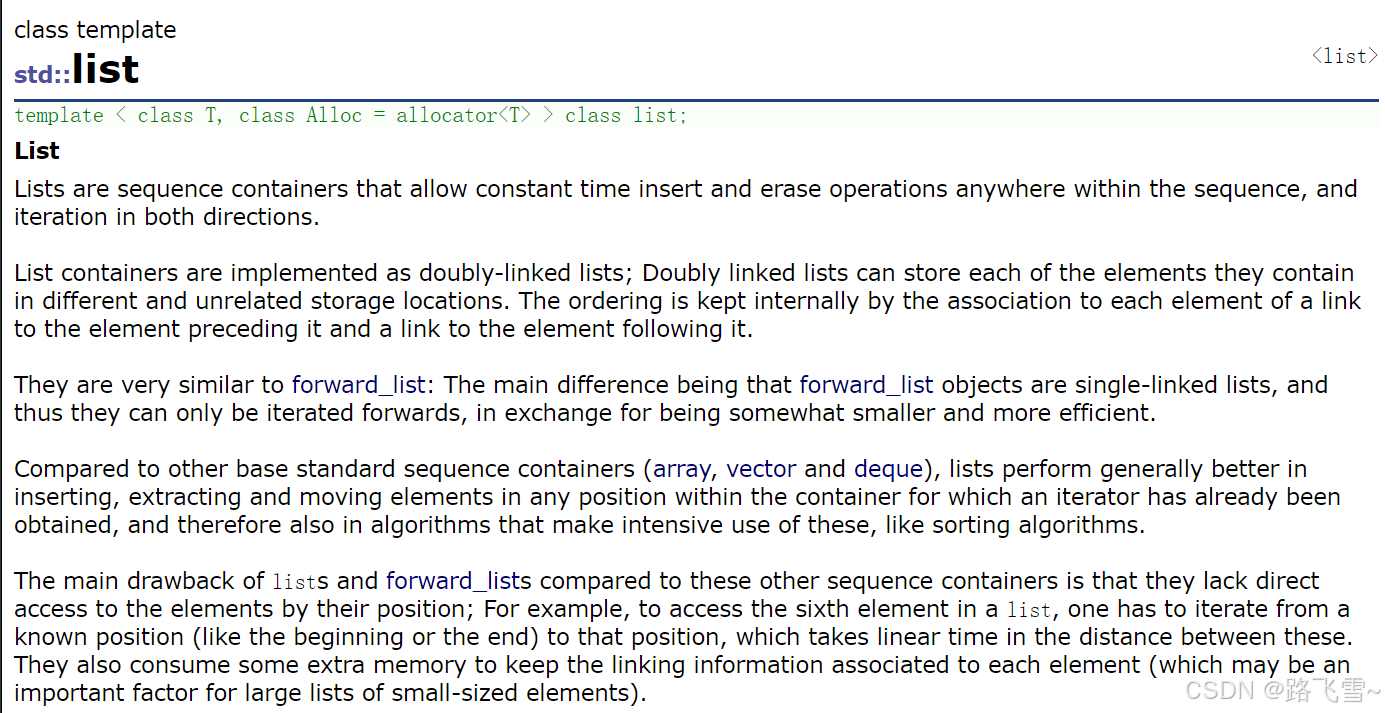
1. list是可以在常数范围内在任意位置进行插入和删除的序列式容器,并且该容器可以前后双向代。
2. list的底层是双向链表结构,双向链表中每个元素存储在互不相关的独立节点中,在节点中通过指针指向其前一个元素和后一个元素。
3. list与forward_list非常相似:最主要的不同在于forward_list是单链表,只能朝前迭代,已让其更简单高效。
4. 与其他的序列式容器相比(array,vector,deque),list通常在任意位置进行插入、移除元素的执行效率更好。
5. 与其他序列式容器相比,list和forward_list最大的缺陷是不支持任意位置的随机访问,比如:要访问list的第6个元素,必须从已知的位置(比如头部或者尾部)迭代到该位置,在这段位置上迭代需要线性的时间开销;list还需要一些额外的空间,以保存每个节点的相关联信息(对于存储类型较小元素的大list来说这可能是一个重要的因素)

二、list 的基本使用
🎉list的构造

| 构造函数 | 接口说明 |
| list (size_type n, const value_type& val=value_type()) | 构造的list中包含n个值为val的元素 |
| list() | 构造空的list |
| list (const list& x) | 拷贝构造函数 |
| list ( InputIterator first, InputIterator last) | 用 [ first , last ) 区间中的元素构造list |
#include<iostream>
#include<list>using namespace std; int main()
{list<int> l1; //构造空的l1list<int> l2(4, 100); // 构造4个值为100的元素list<int> l3(l2.begin(), l2.end()); //用l2的[begin(),end())左闭右开区间构造l3list<int> l4(l3);//以数组为迭代区间构造l5int array[] = { 16,2,77,29 };list<int> l5(array, array + sizeof(array) / sizeof(int));//array array+sizeof(4)//列表格式初始化C++11list<int> l6{ 1,2,3,4,5 };//用迭代器方式打印l5中的元素list<int>::iterator it = l5.begin();while (it != l5.end()){cout << *it << " ";++it;}cout << endl;//C++范围for的方式遍历for (auto& e : l5){cout << e << " ";}cout << endl;return 0;
}
🎉list iterator 的使用




此处,可以暂时将迭代器理解成一个指针,该指针指向list中的某个结点。
| 函数声明 | 接口说明 |
| begin() + end() | 返回第一个元素的迭代器+返回最后一个元素下一个位置的迭代器 |
| rbegin() + rend() | 返回第一个元素的 reverse_iterator, 即end位置,返回最后一个元素下一个位置的 reverse_iterator,即begin位置 |
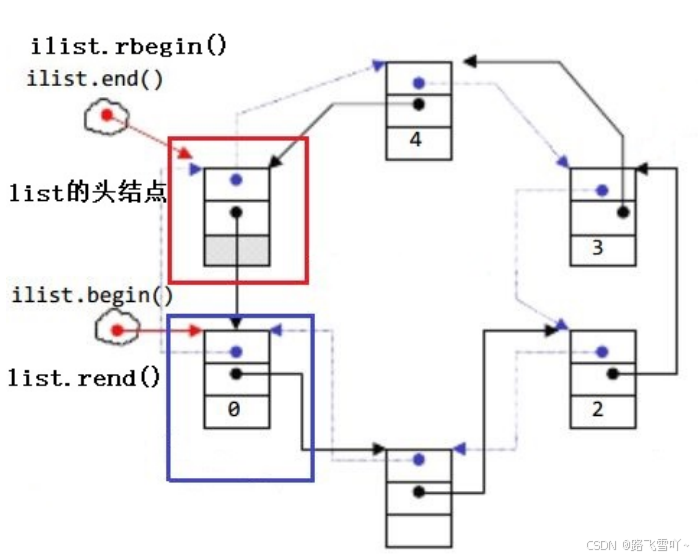
//list迭代器的使用
//注意:遍历链表只能用迭代器和范围for
void Printlist( const list<int>& l )
{//注意这里调用的是list的 begin() const,返回list的 const_iterator对象for (list<int>::const_iterator it = l.begin(); it != l.end(); ++it){cout << *it << " ";//*it = 10; 编译不通过}cout << endl;
}#include<iostream>
#include<list>using namespace std; int main()
{int array[] = { 1, 2, 3, 4, 5, 6, 7, 8, 9, 0 };list<int> l(array, array + sizeof(array) / sizeof(array[0]));//使用正向迭代器正向list中的元素//list<int>::iterator it=l.begin(); //C++98中的语法auto it = l.begin();//C++11之后的推荐写法while (it != l.end()){cout << *it << " ";++it;}cout << endl;//使用反向迭代器逆向打印list中的元素//list<int>::reverse_iterator rit = l.rbegin();auto rit = l.rbegin();while (rit != l.rend()){cout << *rit << " ";++rit;}cout << endl;return 0;
}
【注意】
1、begin与end为正向迭代器,对迭代器执行++操作,迭代器向后移动
2、rbegin(end) 与 rend(begin)为反向迭代器,对迭代器执行++操作,迭代器向前移动
🎉list capacity



| 函数说明 | 接口说明 |
| empty() | 检测list是否为空,是返回ture,否则返回false |
| size() | 返回list中有效节点的个数 |
| max_size() | 返回列表容器可以容纳的最大元素数 |
#include<iostream>
#include<list>using namespace std;int main ()
{std::list<int> mylist;int sum (0);for (int i=1;i<=10;++i) mylist.push_back(i);while (!mylist.empty()){sum += mylist.front();mylist.pop_front();}std::cout << "total: " << sum << '\n';return 0;
} 
#include<iostream>
#include<list>using namespace std;int main()
{std::list<int> myints;std::cout << "0. size: " << myints.size() << '\n';for (int i = 0; i < 10; i++){myints.push_back(i);}std::cout << "1. size: " << myints.size() << '\n';myints.insert(myints.begin(), 10, 100);for (list<int>::const_iterator it = myints.begin(); it != myints.end(); ++it){cout << *it << " ";}cout << endl;std::cout << "2. size: " << myints.size() << '\n';myints.pop_back();std::cout << "3. size: " << myints.size() << '\n';return 0;
}
🎉list element access


| 函数声明 | 接口说明 |
| front | 返回list的第一个节点中值的引用 |
| back | 返回list的最后一个节点中值的引用 |
🎉list modifiers




| 函数声明 | 接口说明 |
| push_front() | 在list首元素前插入值为val的元素 |
| pop_front() | 删除list中第一个元素 |
| push_back() | 在list的尾部插入值为val的元素 |
| pop_back() | 删除list中最后一个元素 |
#include<iostream>
#include<list>using namespace std;void Printlist(const list<int>& l)
{//注意这里调用的是list的begin() const,返回list的 const_iterator对象for (list<int>::const_iterator it = l.begin(); it != l.end(); ++it){cout << *it << " ";//*it = 10;编译不通过}cout << endl;}int main()
{int array[] = { 1,2,3,4,5,6,7,8,9 };list<int> L(array, array + sizeof(array) / sizeof(array[0]));//尾插 头插L.push_back(4);L.push_front(0);Printlist(L);//尾删 头删L.pop_back();L.pop_front();Printlist(L);return 0;
} 


| 函数声明 | 接口说明 |
| insert | 在list position 位置中插入值为val的元素 |
| erase | 删除list position 位置的元素 |
#include<iostream>
#include<list>
#include<vector>using namespace std;
int main()
{int array[] = { 1,2,3 };list<int> L(array, array + sizeof(array) / sizeof(array[0]));//获取链表中的第二个结点//list<int>::iterator it = ++L.begin();auto pos = ++L.begin();cout << *pos << endl;//在pos前插入值为4的元素L.insert(pos, 4);Printlist(L);// 在pos前插入5个值为5的元素L.insert(pos, 5, 5);Printlist(L);// 在pos前插入[v.begin(), v.end)区间中的元素vector<int> v{ 7,8,9 };L.insert(pos, v.begin(), v.end());Printlist(L);// 删除pos位置上的元素L.erase(pos);Printlist(L);// 删除list中[begin, end)区间中的元素,即删除list中的所有元素L.erase(L.begin(), L.end());Printlist(L);return 0;
}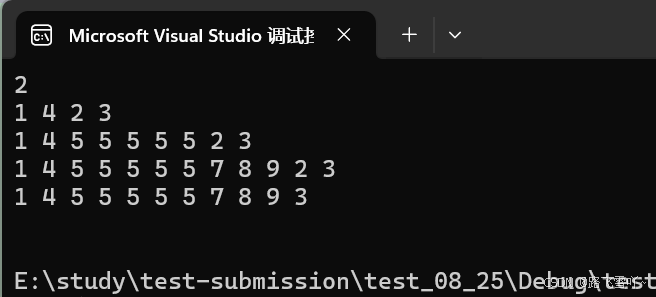



| 函数声明 | 接口说明 |
| swap | 交换两个list中的元素 |
| resize | 调整容器的大小,使其包含n个元素 |
| clear | 清空list中的有效元素 |
#include<iostream>
#include<list>using namespace std;int main()
{
// 用数组来构造listint array[] = { 1,2,3 };list<int> L1(array, array + sizeof(array) / sizeof(array[0]));Printlist(L1);// 交换l1和l2中的元素list<int> L2;L1.swap(L2);Printlist(L1);Printlist(L2);// 将l2中的元素清空L2.clear();cout << L2.size() << endl;return 0;
} 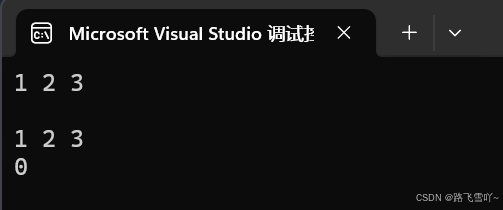
🎉list operator

(1)将元素从列表转移到列表
(2)将元素从x转移到容器中,并将其插入到指定位置
(3)有效地将这些元素插入容器中,并将其从x中删除,从而改变了两者的大小容器。该操作不涉及任何元素的构造或销毁,无论x是左值还是右值,或者值类型是否支持移动构造,它们都会被转移。第一个版本(1)将x的所有元素转移到容器中。
第二个版本(2)只将i指向的元素从x转移到容器中
第三个版本(3)将范围[first,last)从x转移到容器中。

| 函数声明 | 接口函数 |
| splice | 将元素从列表转移到列表(剪切) |
| merge | 合并已排序列表 |
#include<iostream>
#include<list>using namespace std;int main()
{std::list<int> mylist1, mylist2;std::list<int>::iterator it;for (int i = 1; i <= 4; ++i)mylist1.push_back(i); //mylist1: 1 2 3 4for (int i = 1; i <= 3; ++i)mylist2.push_back(i * 10); //mylist2: 10 20 30it = mylist1.begin();++it; //position to 2mylist1.splice(it, mylist2); //mylist1: 1 10 20 30 2 3 4 // mylist2(empty)return 0;
}三、list 的模拟实现
🌟模拟实现list
list的底层是双向链表结构,双向链表中每个元素存储在互不相关的独立节点中,在节点中通过指针指向其前一个元素和后一个元素,因此模拟实现时,要对双链表的节点进行封装,list对元素进行访问时,不能用普通的迭代器进行访问下一个元素,因为双链表在物理上是不连续的,因此又要对双链表的迭代器进行封装。
这里我们对list的模拟实现放在一个头文件进行实现,我们要写在一个命名空间里面,为了避免命名冲突或名字污染,对(带头双向循环链表)双链表的节点进行封装 :
// List.h
namespace xlf
{//双链表的定义//类模板template<class T>struct ListNode{// ListNode<T>*是一个类型 例:int*ListNode<T>* _prev; //指向前一个节点的指针ListNode<T>* _next;//指向后一个节点的指针T _data;//节点的数据//构造ListNode(const T& data):_prev(nullptr),_next(nullptr),_data(data){}};}• 为什么用 struct 而不用 class 来创建类呢?
struct 不受访问限定符的限制,class 使用受限,如果使用class,则要把成员函数和成员变量全部设为公有,这里的ListNode节点要经常使用。
template 定义的模板参数,只能供当前类或当前函数使用
对List进行封装:
template<class T>class List{typedef ListNode<T> Node; //为类型取别名public://节点初始化//双链表有哨兵位List(){_head = new Node(T());//用匿名对象进行初始化_head->_prev = _head;_head->_next = _head;}//尾插void push_back(const T& x){//创建新节点Node* newnode = new Node(x);//找尾节点Node* tail = _head->_prev;//连接newnode->_prev = tail;//1tail->_next = newnode;//2newnode->_next = _head;//3_head->_prev = newnode;//4}private:Node* _head;};哨兵位如何初始化?
此时,当我们对链表的数据进行访问/修改时,我们不能用普通的迭代器进行访问,链表在物理空间上是不连续的,因此我们需要对迭代器进行封装:
//链表迭代器template<class T>struct ListIterator{typedef ListNode<T> Node;//给节点取别名typedef ListIterator<T> Self;//給迭代器取别名Node* _node;//节点public://构造函数ListIterator(Node* node):_node(node){}//对自定义进行运算符的重载,可控制迭代器的行为};现在我们来实现一般所需的重载运算符:
• 对自定义类型运算符的重载,可控制迭代器的行为。
🎉前置operator++/operator--
Self& operator++()//出了当前作用域不销毁,用传引用返回{_node = _node->_next;return *this;}Self& operator--()//出了当前作用域不销毁,用传引用返回{_node = _node->_prev;return *this;}• 传引用返回,是因为出了当前作用域,*this这个值不销毁
• _node=_node->_next 表示这个节点的下一个节点
• _node=_node->_prev 表示这个节点的前一个节点
🎉 后置operator++(int) / operator--(int)
Self operator++(int)//出了作用域这个值会销毁,用传值返回{Node* temp(*this); // d++ :返回的是++之前的值// 所以要先保留++之前的值_node = _node->_next;return temp;}Self operator--(int)//出了作用域这个值会销毁,用传值返回{Node* temp(*this); // d-- :返回的是--之前的值// 所以要先保留--之前的值_node = _node->_prev;return temp;}• 前置++和后置++的区别:(返回值不一样)
++d :返回++之后的值
d++:返回++之前的值
• Node* temp(*this) 表示先保留++/-- 之前的值,当做返回值
•用传值返回,是因为 temp 出了当前作用域后,就会被销毁
🎉operator!=/operator==
bool operator!=(const Self& it){return _node != it._node;}bool operator==(const Self& it){return _node == it._node;}🎉operator*()
T& operator*(){return _node->_data;}
为什么重载 operator*() 呢?
• 重载operator*(),是为了可以获取到节点里面的数据。
测试例子:
List<int>::iterator it = L.begin();while (it != L.end()){cout << *it << " ";//*it 解引用要的是数值,不是节点,所以运算符重载了operator*()++it;}cout << endl;🎉operator->()
const T* operator->(){return &_node->_data;}为什么重载operator->()呢?
看这个例子:
struct Pos{int _row;int _col;Pos( int row = 0,int col = 0):_row(row),_col(col){}};void test_list3(){List<Pos> L;L.push_back(Pos(100, 100));L.push_back(Pos(200, 200));L.push_back(Pos(300, 300));List<Pos>::iterator it = L.begin();while (it !=L. end()){cout << it->_row << ":" << it->_col << endl;//cout << it.operator->()->_row << ":" << it.operator->()->_col << endl;++it;}cout << endl;}• 我们访问 int类型,可以用int*,如果我们访问 Pos* 这个自定义类型数据该如何访问?重载运算符,在结构体、类(公有),想访问成员,模拟这个行为,可以用 -> 来进行访问。
• cout << it->_row << ":" << it->_col << endl 实际为:
cout << it.operator->()->_row << ":" << it.operator->()->_col << endl;
第一个->:运算符重载的调用;
第二个->:原生指针

🎉迭代器iterator
此时就可以在List类里面实现部分迭代器:
template<class T>class List{typedef ListNode<T> Node; //为类型取别名public:typedef ListIterator<T> iterator;iterator begin(){iterator it(_head->_next);return it;}iterator end(){iterator it(_head);return it;}}测试迭代器:
void test_list1(){List<int> L;//实例化就报错L.push_back(1);L.push_back(2);L.push_back(3);L.push_back(4);List<int>::iterator it = L.begin();while (it != L.end()){*it += 10; // *it 解引用,返回的是这个节点的数据// 此时可以修改这个节点数据的内容cout << *it << " ";//*it 解引用要的是数值,不是节点,所以运算符重载了operator*()++it;}cout << endl;for (auto& e : L){cout << e << " ";}cout << endl;}
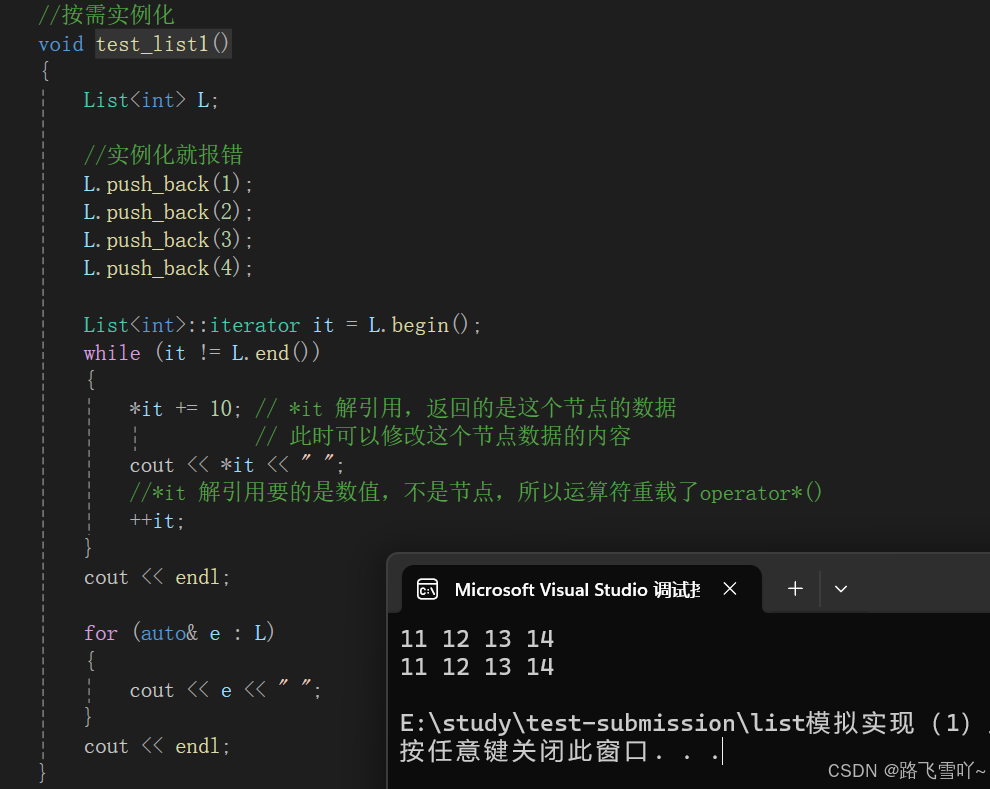

🎉迭代器const_iterator
如何做到自己能修改,指向的内容不能修改?
迭代器只能控制,不能修改的核心行为是 operator*()、operator->(),就是解引用时,要修改的东西。
// const_iterator//链表迭代器template<class T>struct ListConstIterator{typedef ListNode<T> Node;//给节点取别名typedef ListConstIterator<T> Self;//給迭代器取别名Node* _node;//节点public://构造函数ListConstIterator(Node* node):_node(node){}//对自定义进行运算符的重载,可控制迭代器的行为Self& operator++(){_node = _node->_next;return *this;}Self& operator--(){_node = _node->_prev;return *this;}Self operator++(int){Node* temp(*this);_node = _node->_next;return temp;}Self operator--(int){Node* temp(*this);_node = _node->_prev;return temp;}bool operator!=(const Self& it){return _node != it._node;}bool operator==(const Self& it){return _node == it._node;}const T& operator*(){return _node->_data;}const T* operator->(){return &_node->_data;}};• 实现与iterator()相似,区别就在于operator*() 和 operator->() 这两个运算符重载改为const,
即: const T& operator*(); const T* operator->()
• const iterator const 迭代器不能是普通迭代器前面加 const修饰
const迭代器目的:本身可以修改,指向的内容不能修改
例: const T* p ; p本身可以修改,*p不可以修改
代码测试:
void Func(const List<int>& lt){List<int>::const_iterator it = lt.begin();while (it!=lt.end()){//*it += 10; //const迭代器 指向的内容不能改变cout << *it << " ";//可读++it;//可遍历}cout << endl;}
迭代器的另一种写法:
通过模板,给不同模板参数,让编译器帮我们写两个类(实例化)。
//迭代器的第二种写法:
//template 定义的模板参数,只能供当前类或当前函数使用//链表迭代器template<class T, class Ref, class Ptr>struct ListIterator{typedef ListNode<T> Node;//给节点取别名typedef ListIterator<T, Ref, Ptr> Self;//給迭代器取别名Node* _node;//节点public://构造函数ListIterator(Node* node):_node(node){}//对自定义进行运算符的重载,可控制迭代器的行为Self& operator++(){_node = _node->_next;return *this;}Self& operator--(){_node = _node->_prev;return *this;}Self operator++(int){Node* temp(*this);_node = _node->_next;return temp;}Self operator--(int){Node* temp(*this);_node = _node->_prev;return temp;}bool operator!=(const Self& it){return _node != it._node;}bool operator==(const Self& it){return _node == it._node;}Ref operator*(){return _node->_data;}Ptr operator->(){return &_node->_data;}};• template <class T , class Ref , class Ptr> 通过模板给不同模板参数;
• typedef ListIterator<T, Ref, Ptr> Self; typedef时也要做相应的修改,此时表示当传入的 Ref 和 Ptr 为常量时, Ref 和 Ptr就会替代为常量;当传入的 Ref 和 Ptr 为非常量时, Ref 和 Ptr就会替代为非常量;
• 改变 operator*() 的返回值类型从 T& 修改为 Ref ,
改变 operator->() 的返回值类型从 T* 修改为 Ptr ,
这时返回值的类型看传给 Ref / Ptr 是什么 ;
•此时 List类 中修改
typedef ListIterator<T> iterator —> typedef ListIterator<T , T&, T*> iterator;
typedef ListConstIterator<T> const_iterator —> typedef ListIterator<T, const T&, const T*> const_iterator;
🌟List相关接口函数的模拟实现 :
🎉insert()
//插入(在pos之前插入)iterator insert(iterator pos, const T& x){//找到Pos位置的节点Node* cur = pos._node;//开一个新节点Node* newnode = new Node(x);//找pos的前一个节点Node* prev = cur->_prev;//连接 prev newnode curprev->_next = newnode;newnode->_prev = prev;newnode->_next = cur;cur->_prev = newnode;return iterator(newnode);} 
🎉erase()
iterator erase(iterator pos){//防止删掉哨兵位// pos end() 都是迭代器,_head是指针,所以不用assert(pos != end());//找到posNode* cur = pos._node;//pos的前一个节点Node* prev = cur->_prev;//pos的后一个节点Node* next = cur->_next;//连接 prev nextprev->_next = next;next->_prev = prev;//删除节点delete cur;return iterator(next);}🌟迭代器失效问题
大家可将迭代器展示理解成类似于指针,迭代器失效及迭代器所指向的节点无效,即该节点被删除了。因为list的底层结构为带头结点的双向循环链表,因此在李斯特中进行插入时是不会导致list的迭代器失效的,只有删除时才会失效,并且时效的只是指向被删除节点的迭代器,其他迭代器不会受到影响。
void test_list(){int array[] = { 1,2,3,4,5,6,7,8,9 };List<int> L(array, array + sizeof(array) / sizeof(array[0]));auto it = L.begin();while (it != L.end()){//erase()函数执行后,it所指向的节点已被删除,// 因此it无效,在下一次使用it时,必须先给其重新赋值it = L.erase(it);++it;}}🎉尾删/头删/头插
//尾删void pop_back(){erase(--end());}//头删void pop_front(){erase(begin());}//头插void push_front(const T& x){insert(begin(), x);}
直接复用前面模拟实现过的函数。
🎉List()
//节点初始化//双链表有哨兵位List(){_head = new Node(T());//创建一个T()类型的节点_head->_prev = _head;//节点前后都指向自己_head->_next = _head;}因为下面的几个函数实现都需要初始化,所以把初始化写成一个函数。
//哨兵位头节点void empty_init(){_head = new Node(T());_head->_next = _head;_head->_prev = _head;}//节点初始化//双链表有哨兵位List(){//_head = new Node(T());//创建一个T()类型的节点//_head->_prev = _head;//节点前后都指向自己//_head->_next = _head;empty_init();}🎉深拷贝List(const List<T>& lt)
当不实现深拷贝时,系统会自动调用默认构造,此时就是浅拷贝,会出现一些问题:
此时,L1的更新会影响L2的数据,底层实际是L1和L2指向同一块空间,因此需要手动写拷贝构造。
//深拷贝//lt2(lt1)List(const List<T>& lt){//先把原来list里面的数据初始化empty_init();//把lt1里面的数据一个一个尾插到lt2for (const auto& e : lt){push_back(e);}}此时,L1数据的更新不会影响L2:
🎉~List()
在写析构时,我们先要把list里面的数据全部清除,然后再删除头节点的指针并置空。
~List(){clear();delete _head;_head = nullptr;}void clear(){auto it = begin();while (it != end()){it = erase(it);}}🎉List<T>& operator=()
//传值传参//lt1=lt3// 交换两个list的数据后,这两个list还在,所以用传引用返回List<T>& operator=(List<T> lt)//lt3出了当前作用域不销毁,所以用传引用返回{swap(_head, lt._head);//直接用库里面的函数return * this;}🎉初始化initializer_list
List(initializer_list<T> il){empty_init();for (const auto& e : il){push_back(e);}}四、list 和 vector 的对比
vector与list都是STL中非常重要的序列式容器,由于两个容器的底层结构不同,导致其特性以及应用场景不同,其主要不同如下:
| vector | list | |
| 底层结构 | 动态顺序表,一段连续空间 | 带头结点的双向循环链表 |
| 随机访问 | 支持随机访问,访问某个元素效率O(1) | 不支持随机访问,访问某个元素效率O(N) |
| 插入和删除 | 任意位置插入和删除效率低,需要搬移元素,时间复杂度为O(N),插入时有空能增容,增容:开辟新空间,拷贝元素,释放旧空间,导致效率更低 | 任意位置插入和删除效率高,不需要搬移元素,时间复杂度为O(1) |
| 空间利用率 | 底层为连续空间,不容易造成内存碎片,空间利用率高,缓存利用率高 | 底层节点动态开辟,小节点容易造成内存碎片,空间利用率低,缓存利用率低 |
| 迭代器 | 原生态指针 | 对原生态指针(节点指针)进行封装 |
| 迭代器失效 | 在插入元素时,要给所有的迭代器进行赋值,因为插入元素可能会导致重新扩容,致使原来迭代器失效,删除时,当前迭代器需要重新赋值否则会失效 | 插入元素不会导致迭代器失效,删除元素时,只会导致当前迭代器失效,其他迭代器不受影响 |
| 使用场景 | 需要高效存储,支持随机访问,不关心插入删除效率 | 大量插入和删除操作,不关心随机访问 |
五、list模拟实现的完整代码
#pragma once
#include<iostream>
#include<assert.h>using namespace std;namespace xlf
{//双链表的定义//类模板template<class T>struct ListNode{// ListNode<T>*是一个类型 例:int*ListNode<T>* _prev; ListNode<T>* _next;T _data;//构造ListNode(const T& data):_prev(nullptr),_next(nullptr),_data(data){}};//迭代器的第一种写法:链表迭代器//template<class T>//struct ListIterator//{// typedef ListNode<T> Node;//给节点取别名// typedef ListIterator<T> Self;//給迭代器取别名// Node* _node;//节点//public:// //构造函数// ListIterator(Node* node)// :_node(node)// {}// //对自定义进行运算符的重载,可控制迭代器的行为// Self& operator++()// {// _node = _node->_next;// return *this;// }// Self& operator--()// {// _node = _node->_prev;// return *this;// }// Self operator++(int)// {// Node* temp(*this);// _node = _node->_next;// return temp;// }// Self operator--(int)// {// Node* temp(*this);// _node = _node->_prev;// return temp;// }// bool operator!=(const Self& it)// {// return _node != it._node;// }// bool operator==(const Self& it)// {// return _node == it._node;// }// T& operator*()// {// return _node->_data;// }// T* operator->()// {// return &_node->_data;// }//};const_iterator链表迭代器//template<class T>//struct ListConstIterator//{// typedef ListNode<T> Node;//给节点取别名// typedef ListConstIterator<T> Self;//給迭代器取别名// Node* _node;//节点//public:// //构造函数// ListConstIterator(Node* node)// :_node(node)// {}// //对自定义进行运算符的重载,可控制迭代器的行为// Self& operator++()// {// _node = _node->_next;// return *this;// }// Self& operator--()// {// _node = _node->_prev;// return *this;// }// Self operator++(int)// {// Node* temp(*this);// _node = _node->_next;// return temp;// }// Self operator--(int)// {// Node* temp(*this);// _node = _node->_prev;// return temp;// }// bool operator!=(const Self& it)// {// return _node != it._node;// }// bool operator==(const Self& it)// {// return _node == it._node;// }// const T& operator*()// {// return _node->_data;// }// const T* operator->()// {// return &_node->_data;// }//};//迭代器的第二种写法:
//template 定义的模板参数,只能供当前类或当前函数使用//链表迭代器template<class T, class Ref, class Ptr>struct ListIterator{typedef ListNode<T> Node;//给节点取别名typedef ListIterator<T, Ref, Ptr> Self;//給迭代器取别名Node* _node;//节点public://构造函数ListIterator(Node* node):_node(node){}//对自定义进行运算符的重载,可控制迭代器的行为Self& operator++(){_node = _node->_next;return *this;}Self& operator--(){_node = _node->_prev;return *this;}Self operator++(int){Node* temp(*this);_node = _node->_next;return temp;}Self operator--(int){Node* temp(*this);_node = _node->_prev;return temp;}bool operator!=(const Self& it){return _node != it._node;}bool operator==(const Self& it){return _node == it._node;}Ref operator*(){return _node->_data;}Ptr operator->(){return &_node->_data;}};//链表实现template<class T>class List{typedef ListNode<T> Node; //为类型取别名public:迭代器的第一种写法://typedef ListIterator<T> iterator;//typedef ListConstIterator<T> const_iterator;//迭代器的第二种写法:typedef ListIterator<T, T&, T*> iterator;typedef ListIterator<T, const T&, const T*> const_iterator;iterator begin(){/*iterator it(_head->_next);return it;*/return iterator(_head->_next);//匿名对象}iterator end(){/*iterator it(_head->_prev);return it;*/return iterator(_head);//匿名对象}const_iterator begin() const{/*const_iterator it(_head->_next);return it;*/return const_iterator(_head->_next);//匿名对象}const_iterator end() const{/*const_iterator it(_head);return it;*/return const_iterator(_head);}//尾插void push_back(const T& x){//创建新节点Node* newnode = new Node(x);//找尾节点Node* tail = _head->_prev;//连接 tail newnode _headtail->_next = newnode;newnode->_prev = tail;newnode->_next = _head;_head->_prev = newnode;//insert(end(), x);}//插入(在pos之前插入)iterator insert(iterator pos, const T& x){//找到Pos位置的节点Node* cur = pos._node;//开一个新节点Node* newnode = new Node(x);//找pos的前一个节点Node* prev = cur->_prev;//连接 prev newnode curprev->_next = newnode;newnode->_prev = prev;newnode->_next = cur;cur->_prev = newnode;return iterator(newnode);}iterator erase(iterator pos){//防止删掉哨兵位// pos end() 都是迭代器,_head是指针,所以不用assert(pos != end());//找到posNode* cur = pos._node;//pos的前一个节点Node* prev = cur->_prev;//pos的后一个节点Node* next = cur->_next;//连接 prev nextprev->_next = next;next->_prev = prev;//删除节点delete cur;return iterator(next);}//尾删void pop_back(){erase(--end());}//头删void pop_front(){erase(begin());}//头插void push_front(const T& x){insert(begin(), x);}//哨兵位头节点void empty_init(){_head = new Node(T());_head->_prev = _head;_head->_next = _head;}//节点初始化//双链表有哨兵位List(){//_head = new Node(T());//创建一个T()类型的节点//_head->_prev = _head;//节点前后都指向自己//_head->_next = _head;empty_init();}//深拷贝//lt2(lt1)List(const List<T>& lt){//先把原来list里面的数据初始化empty_init();//把lt1里面的数据一个一个尾插到lt2for (const auto& e : lt){push_back(e);}}~List(){clear();//清空list里面的数据delete _head;//释放头节点_head = nullptr;//头节点指针置为空,防止出现野指针}void clear(){auto it = begin();while (it != end()){it = erase(it);}}//传值传参//lt1=lt3// 交换两个list的数据后,这两个list还在,所以用传引用返回List<T>& operator=(List<T> lt)//lt3出了当前作用域不销毁,所以用传引用返回{swap(_head, lt._head);//直接用库里面的函数return * this;}List(initializer_list<T> il){empty_init();for (const auto& e : il){push_back(e);}}private:Node* _head;};//按需实例化void test_list1(){List<int> L;//实例化就报错L.push_back(1);L.push_back(2);L.push_back(3);L.push_back(4);List<int>::iterator it = L.begin();while (it != L.end()){*it += 10; // *it 解引用,返回的是这个节点的数据// 此时可以修改这个节点数据的内容cout << *it << " ";//*it 解引用要的是数值,不是节点,所以运算符重载了operator*()++it;}cout << endl;for (auto& e : L){cout << e << " ";}cout << endl;}struct Pos{int _row;int _col;Pos( int row = 0,int col = 0):_row(row),_col(col){}};void test_list3(){List<Pos> L;L.push_back(Pos(100, 100));L.push_back(Pos(200, 200));L.push_back(Pos(300, 300));List<Pos>::iterator it = L.begin();while (it !=L. end()){cout << it->_row << ":" << it->_col << endl;++it;}cout << endl;}void Func(const List<int>& lt){//List<int>::const_iterator it = lt.begin();//while (it!=lt.end())//{// //*it += 10; //const迭代器 指向的内容不能改变// cout << *it << " ";//可读// ++it;//可遍历//}//cout << endl;List<int>::const_iterator it = lt.begin();while (it != lt.end()){//*it += 10;//const迭代器 指向的内容不能修改cout << *it << " ";//可读++it;//可遍历}cout << endl;}void test_List3(){List<int> L;L.push_back(1);L.push_back(2);L.push_back(3);L.push_back(4);L.push_back(5);Func(L);L.push_front(10);L.push_front(20);L.push_front(30);Func(L);L.pop_front();L.pop_front();Func(L);L.pop_back();L.pop_back();L.pop_back();/*L.pop_back();L.pop_back();L.pop_back();L.pop_back();L.pop_back();L.pop_back();*/Func(L);}void test_List4(){List<int> L1;L1.push_back(1);L1.push_back(2);L1.push_back(3);L1.push_back(4);L1.push_back(5);Func(L1);List<int> L2(L1);L1.push_back(6);Func(L2);Func(L1);List<int> L3;L3.push_back(1);L3.push_back(2);L3.push_back(3);L1 = L3;Func(L1);Func(L3);}void test_List5(){List<int> L1 = { 1,2,3,4,5,6 };Func(L1);}}如若对你有帮助,记得点赞、收藏、关注哦!
若有误,望各位,在评论区留言或者私信我 指点迷津!!!谢谢^ ^ ~
















冒泡排序和其优化)







